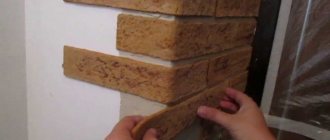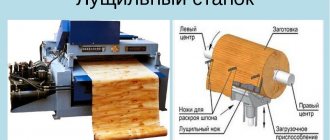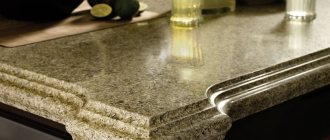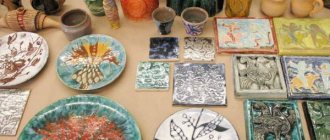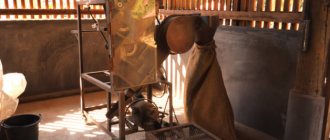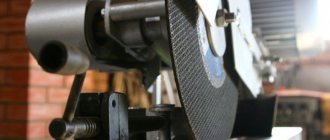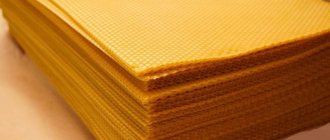European thrift has once again given the construction market something special. Unique finishing material “Flexible stone”. Conventionally, such a finish can be called artificial stone, but only conditionally, since natural components and binding polymers are used. Thermoplastic acrylic adhesive (styrene-acrylic, silicone-acrylic) fixes the thinnest section of sandstone or bulk small fractions of stone: marble chips, quartz sand on a textile base. On the surface, flexible stone is difficult to distinguish from natural stone, and its durability meets the highest demands.
The beauty of flexible sandstone cut stone is undeniable. But the technology for its manufacture is quite complex, highly precise and not suitable for handicraft production. But you can do without complex equipment to make a flexible stone from a layer of crumbs. Home production for personal needs will not require anything that a thrifty owner would not have on a country plot. And such material can be as beautiful as its more expensive counterpart, if you use your imagination.
Flexible stone can imitate brickwork if crushed scrap brick is applied to the surface through a stencil placed on a prepared base. The “inter-brick seams” are then sealed with decorative grout for ceramic tiles.
Characteristics and application of flexible stone
Flexible stone is an excellent finishing material, thanks to its flexibility and relative lightness, it is successfully used in various types of construction work: interior decoration of apartments, exterior and interior decoration of country houses, design of country gazebos and retaining walls.
Sandstone mined in a quarry, from which flexible stone is made, is impregnated with a special adhesive acrylic composition to 1-3 mm, cut and sent to production, where its outer side is processed. Then the resulting cut is fixed on a flexible base - a fibrous web. The finished sheets of such sandstone are thin - 2-3 mm - and flexible.
Flexible stone is available in sheets and slabs. Rolled stone is sold in sizes 1020*2200 mm, and tiles - 340*550 mm, 160*265 mm, 80*265 mm. You can buy a flexible stone of any shade and size at a price of up to 2,500 rubles. for 1 m?.
Technical characteristics of flexible stone:
- Fire resistance.
- Environmentally friendly.
- Ease.
- Strength.
- Frost resistance.
- Waste-free - damaged parts of flexible stone can be replaced with preserved pieces of the same shade and texture that remained during the work.
- Easy to use - no special surface preparation is required when covering it with flexible stone. The stone is glued quite simply, like ordinary wallpaper or mosaic.
- Spectacular appearance.
- Elasticity - there are no cracks or creases when bending, so this material can be used to safely decorate corners and various uneven surfaces (a flexible stone will successfully hide all the imperfections of the area being covered).
But still, in this case, it is recommended to use an installation hairdryer, which, by heating the flexible stone, will help you make it even softer and give it the desired shape: sheathing corners, columns, spherical decorative elements, etc. Having finished installing the flexible stone in the corner, go over both sides of it with a roller, pressing the stone wallpaper to the surface to be glued.
There is an opinion that this material is based on plastic, but this is a misconception. This material, the imperfections of which are quite difficult to notice, is a section of sandstone of natural origin, which was then transferred to flexible fiberglass, which is used as the base of the resulting stone.
In construction stores, the material is provided in the form of wallpaper, the size of rolls of which, as a rule, ranges from two to 2.8 meters, as well as tiles and veneers. By using such wall decoration and mastering all the existing subtleties of working with it, you will be able to achieve an aesthetically phenomenal result.
Every person realizes, especially the builder, that each building material has its own individual characteristics: advantages and imperfections. Flexible stone, unfortunately, is no exception. Its imperfections are hard to notice, but they are there.
- This material is made from natural ingredients, therefore it is considered a harmless building material. It releases harmful compounds in minute quantities during operation.
- Decorating walls with flexible stone is relatively simple, since this material has extremely low water resistance, but at the same time its composition is fireproof, which is important to consider during repairs.
- Due to the fact that this building material is relatively light in weight, it is successfully used and glued to decorate various decorative elements and building structures, for example: facade or interior elements.
- The specified material is extremely easy to use and does not require special measures related to its care.
- The high durability of flexible stone makes it even more in demand and popular. According to respected experts, the expected service life of the material is about thirty-five years.
- Manufacturers assure their potential buyers that the material is heat-resistant and can withstand a wide range of temperature fluctuations (from -45 to 650 degrees).
- Due to the fact that the use of stone allows for extremely unexpected configurations, the most unpredictable and unusual design ideas can be realized.
Perhaps the only but significant drawback of the substance is its high price. Pricing policy varies from 500 to 7 thousand rubles per 1 sq. m. m, but if a potential client prefers quality products from a reputable manufacturer, then the purchase will cost him an amount that will start from 1,300 rubles per 1 sq. m. m.
Due to its durability, resistance to aggressive environments, and beautiful texture, flexible stone is used for insulation and finishing of facades, as well as indoors:
- wall decoration;
- partitions;
- stairs;
- doors;
- fireplaces.
Its low weight and ductility allow the material to be used for cladding structures of any shape and size. Flexible stone has found application in landscape design: laying paths, decorating fences, fountains, or creating panels. The material has the following qualities:
- fireproof;
- waterproof;
- environmentally friendly;
- does not contain harmful additives;
- antistatic;
- flexible and ductile, easy to cut;
- has low weight;
- vapor permeable;
- withstands temperature changes.
It brings sophistication and naturalness to the interior. If we add to this the ease of installation, it becomes clear why the material quickly became in demand.
The disadvantages include the high cost of flexible stone if it was made in quarries.
Another significant drawback of the material is its abrasive and relief surface to varying degrees.
Main properties of flexible stone:
- affordable price;
- environmental cleanliness;
- water resistance;
- simplicity and ease of installation, thanks to plasticity and small thickness (up to 10 mm);
- vapor permeability;
- combustion resistance;
- light weight;
- high antistatic characteristics;
- durability;
- light transmittance;
- absence of formaldehyde.
Due to its high performance and technical characteristics, the material is widely used in the interior and exterior decoration of facades, ceilings and other surfaces, cladding stairs, fences, fireplaces, and fountains. It is used in interior decoration and landscape design. It is used to create mosaics, frescoes and panels.
There are two completely different technologies for producing flexible stone: in a specially equipped room and at a sandstone mining site. In order for the enterprise to generate income, it is necessary to study in more detail the secrets of producing flexible stone.
The technology for producing flexible stone at the mining site is quite costly and labor-intensive. To organize such a business, you must have certain skills and experience.
The mini workshop must be installed on the territory of sandstone deposits. The material is a canvas based on polymers and textiles, covered with a layer of sandstone. The main stages of the process are as follows:
- selection and preparation of cuts with a unique ornament;
- grinding work;
- applying acrylic mixture;
- covering the supporting base made of fiberglass or textile;
- removing the base;
- drying.
Requires the purchase of expensive equipment. Because the main task in production is choosing a textured cut of natural material, leveling the surface and removing a very thin layer. An adhesive or resin is applied to the base, on which a layer of sandstone is laid. After removing the textile with the imprint of the rock pattern, the layer is dried and undergoes special processing and quality control.
Unlike the production of flexible marble in a sandstone mining site, the production of plastic material in a specially equipped room is considered more profitable and less labor-intensive.
An important feature of flexible stone is its ability to be mounted on any surface: a limited number of facade cladding materials are suitable for buildings with non-standard architecture, with rounded walls or rounded corners.
Flexible materials: Do-it-yourself flexible stone: production technology, disadvantages
In this case, flexible stone is the ideal solution to provide decorative and reliable cladding.
In addition, the significant advantages of this type of cladding are the following parameters:
- flexibility. Thanks to this property, flexible stone slabs can be applied to any surface. Using a construction hair dryer for work, you can cover any bends at different angles with this material;
- ease. The material is very light and can be applied even to the thinnest walls. In this way, not only a beautiful design of the wall is ensured, but the surface is also somewhat strengthened;
- thermal stability. Due to this indicator, the material is not afraid of sunlight. Flexible stone is used for interior decoration even when decorating stoves and fireplaces;
- moisture resistance. The material prevents moisture accumulation due to its porous structure;
- decorativeness. A unique pattern is ensured by the random application of stone elements to the base. It is almost impossible to repeat the drawing. By adding various coloring pigments to the coating, not only brightness is ensured, but also the uniqueness of the design;
- environmental friendliness. Due to the inclusion of natural components in the structure of the material, its environmental friendliness is ensured: the material does not emit harmful elements and is not allergic;
- manufacturability and ease of installation. Slabs made of flexible stone are easy to cut with construction scissors, are flexible and lightweight, due to which installation can be done with one hand without special training or specific tools;
- preservation of properties over a wide range of temperature differences. Due to its heat resistance and relative frost resistance, the flexible material can be used in climatic regions where the air temperature can range from minus 40°C to 700°C;
- durability. When properly used, the material can last more than 35 years. To increase service life, it is especially important to treat the coating with special protective agents in the form of impregnations.
Classic technology
According to the original, classical scheme, production is established in a quarry where there are external sandstone outcrops accessible for free cutting over a large area. The process is only partially mechanized; most of the work is done manually, which affects the cost of the material.
Flexible stone, the production technology of which takes quite a long time, has the following stages of creation:
- The discovered sandstone outcrop is ground until the surface is completely smooth.
- A polymer adhesive composition is applied.
- A fabric base is placed on top.
- Under the influence of the sun, the polymerization process takes place (the connection of the fabric base with the stone).
- The fabric with the sandstone layer is removed.
- Dries in the sun.
The material produced using this technology has an exclusive pattern that is not repeated in any subsequent cut. It is used for finishing work, production of souvenirs, decorative elements, etc.
How is flexible stone made?
This building material is produced manually using two technologies. One of them is production in the workshop. Anyone who wants to open their own business needs to purchase a minimum set of equipment, including a drill, a sand seeder, drying cabinets, and equipment for cutting the finished product. The manufacturing technology is very simple and does not require special knowledge or training.
It includes the following processes:
- sifting marble chips (or sand), if necessary, painting;
- preparation of the base (gluing fiberglass);
- application of mineral raw materials to the base;
- drying;
- cutting the finished layer into tiles of the required size.
The profitability of small production is quite high, because the cost of tiles is several times lower than on the construction market.
Another thing is production using original technology in areas of sandstone deposits, which turns out to be more labor-intensive and expensive. The sandstone cut has a unique pattern, resulting in a material with a distinctive texture. The high costs are explained by the fact that the equipment for producing flexible stone is expensive.
Flexible Stone Making Machine
Without it, it is impossible to complete the most important process - sanding the base. The production stages are as follows:
- selecting the desired cut of sandstone as a base, polishing it;
- applying a polymer binder to the formation;
- covering the base with fiberglass or other textiles;
- removing fabric with an imprint of a sand layer after a certain time;
- drying the product.
Finishing material is produced in the form of wallpaper or tiles. Despite the demand, stone production has not yet been established on a large scale. The market offers mainly products from foreign manufacturers. Therefore, there are good prospects for medium and small businesses.
Flexible stone workshop
Technological process
The production of flexible stone occurs sequentially and consists of the following stages:
- If coloring is necessary, you need to mix quartz sand or other bulk materials with pigments.
- Fiberglass is laid on the prepared template, which is treated with an adhesive composition (layer thickness - 2-3 mm).
- The bulk material is distributed over the surface of the treated fabric (if desired, you can alternate colors, achieving their transitions).
- The material with applied sand is fixed on the template (you can use nails, buttons, etc.). A rubber roller is used for compaction.
- The completed form is sent to dry, the duration of which depends on the polymer that was used to hold the sand on the fabric.
- During a work shift, one person is able to produce up to 50 square meters of flexible stone.
- After drying, the material is removed from the template. Particles not impregnated with glue will disappear, and the finished sheet can be used for its intended purpose.
Properties and application of flexible stone, its disadvantages
To make flexible stone, you will need marble and fine-grained sifted quartz sand.
You can make flexible stone with your own hands. Here you need to show your imagination. It can be made in the form of tiles or sheets.
Materials and tools for work:
- marble and fine-grained sifted quartz sand;
- sand dyes, which are oxides of various metals and are easily mixed with raw materials, thanks to which you can obtain not only different marble shades, but also completely unusual colors: red, blue, purple, green;
- acrylic latex, which will serve as a binder and flexible base;
- a polyethylene film that serves as a backing and can eventually become integral with the material or be removed when a release agent is applied between it and the material.
- plywood or OSB with 50 mm high bars nailed around the perimeter, serving as pallets for drying finished materials;
- containers for painting and storing mineral raw materials;
- glass sheet 1x1 m;
- a tube made of plastic, glass or metal with a funnel.
Sand dyes are easily mixed with raw materials, thanks to which different marble shades can be obtained.
- Apply a latex base several millimeters thick to the selected substrate.
- Apply mineral sand component in 2-3 shades and distribute it evenly.
- Fix the plywood or OSB in a vertical position and attach the latex-applied backing to it.
- Using slats up to 10 mm thick, install the glass in a vertical position and secure it with tape.
- Lower the tube with a funnel into the resulting mold as low as possible and fill the space between the glass and the sticky base with quartz and marble sand, alternating different colors and shades. Through the glass you will see the resulting pattern. To evaluate the results throughout the filling process, stand back from the mold and examine the resulting patterns.
- Let the latex dry, then disassemble the structure. Part of the sand that does not fall on the adhesive base will fall off. This way you will get patterns that imitate a natural cut, for example, sandstone.
It is best to produce flexible stone on several flat pallets at once, which can be stacked on top of each other and left to dry. The bars attached around the perimeter of the pallets will provide the necessary clearance. Fans can be used to speed up the drying process. They will make air exchange more intense.
The technology for making flexible stone at home is reminiscent of the process of cement or gypsum casting. Before opening such an enterprise, you need to familiarize yourself with some of the production features. The unique properties of a material depend on the mixture underlying its manufacture. The highly elastic polymer additives included in its composition give the material the necessary ductility and strength, which allow it to take any shape.
The stone is often called “flexible marble” because the main component of the mixture is white marble or quartz sand that has undergone special treatment. Sand lends itself perfectly to coloring, while maintaining its natural shine. High mechanical characteristics of flexible stone are achieved using a fiberglass or fabric base.
It is not difficult to buy equipment for the production of flexible stone. An entrepreneur opening a small enterprise at the first stage must purchase the following devices and equipment:
- mixer;
- hand drill;
- a special table where the composition will be applied to the base;
- rack for drying products.
It is important to take into account that the equipment for the production of flexible stone, although it is located in one room (at least 100 m2), but it must be divided into sections. The production area, drying department, raw material warehouse and, separately, finished product warehouse must be defined.
Flexible materials: Do-it-yourself flexible stone: production technology, disadvantages
There are several main stages in the manufacture of elastic material:
- coloring sand or marble chips;
- preparation of glue and base (fabric or fiberglass);
- applying minerals to the base;
- drying the product;
- forming sheets of the desired size and shape.
Making flexible stone with your own hands involves forming tiles, the thickness of which varies from 2.5 mm to 4.5 mm. In this case, the width of the layer reaches 600 mm, and its length is 2.2 meters.
If at the first stage you are engaged in the production of small batches of products, then the workshop can be opened in a small area (about 30 m2) by purchasing a minimum set of equipment.
As for the profitability of such an enterprise, the cost of the product will be about 100 rubles. per one square meter. The average price of flexible stone on the market reaches 700 rubles. for 1 m2. As you can see, the profitability of the enterprise is quite high.
Compared to natural stone, flexible coating has a short service life (while stone cladding can last more than 70 years).
Another point that the consumer is not always happy with is the additional finishing of the coating. It will protect the material from external factors and extend its service life.
The main technical characteristics that a flexible stone coating should have are:
- the weight of 1 m² should not exceed four kilograms;
- operational characteristics withstand a wide temperature range (-45 - (700°));
- the material is capable of creating a gap;
- appearance - has a natural texture;
- non-flammable material;
- inner side - fiberglass or fabric base;
- external side - natural stone (91%);
- binder - polymer dispersion (8%);
- frost resistance - resistance to more than 100 freezing cycles;
- vapor permeability - 0.0052 mg/m/h Pa;
- flammability - G1 according to GOST 3044-94.
The material has increased elasticity and is produced without the use of special solvents.
Important! When choosing flexible stone for a facade, you should check the certificates with the seller.
There are many fakes on the building materials market that do not meet standardization standards and, accordingly, do not have high quality indicators.
Installation of flexible stone has a number of features.
- The material is glued with glue, which is selected according to the polymer used in the production of the material.
- Before finishing, the working surface is treated with antifungal impregnation.
- The adhesive is applied with a brush only to the wall, and then smoothed with a notched trowel for better adhesion.
- To make the stone adhere better to curved surfaces, it is heated with a construction hairdryer. They do the same thing so that the joints are not visible.
- After gluing the finishing material, the protective film with which it goes on sale is removed.
- If the outer surface is lined, the material is impregnated with a special composition to protect it from the effects of natural factors.
If the joints still remain noticeable, they are covered with matching paint or rubbed with scraps of flexible stone. The result of the work can only be assessed upon its completion.
Such a plastic stone can be glued to various hard surfaces: wood, glass, metal. If you have a brick wall in front of you, then first plaster and prime it so that the glue adheres better. The main thing is not to leave sharp bulges and air pockets on the surface.
Carry out work on fastening flexible stone at temperatures above 10 °C.
Use special acrylic glue DV-11 for gluing, which comes in different colors: from colorless to black. At 1 m? you will need 500-600 g of glue.
After gluing the flexible stone, treat it with a protective coating, which is acrylic-silicone impregnation. It will prevent sandstone from crumbling, weathering, fading, and helps repel water and dirt. At 1 m? 200 g of protective coating is consumed.
If finishing work is carried out indoors, then a protective coating should be applied 1-2 times. If the work concerns the facade of the building, then the number of applications is 3-4 times. Remember that a new layer of coating is applied after the previous one has dried. The drying time of the protective coating is approximately 5 hours.
Let us dwell on the stages of work on installing flexible stone.
- Unroll the roll of flexible stone, lay it out on a flat surface, and clean it from dust and grains of sand.
- Coat the surface to be treated and the inside of the flexible stone with glue using a brush.
- Place a roll or tile of stone wallpaper on the surface to be treated and secure it with a pressure roller until air pockets are removed, leaving 3-4 cm on each edge unpressed.
- Prepare the second roll by cutting off a 4 cm wide wavy edge with a mounting knife. Apply glue as indicated above, overlap the sheet with the previous one, and roll it out with a pressure roller.
- Treat the area where the sheets join as follows: cut the bottom sheet along the top sheet, remove the waste, press the seam with a pressure roller.
- After 12 hours of gluing the flexible stone, apply a protective coating to its surface.
How to make it yourself
The production of flexible marble stone is impossible without the following materials and tools:
- marble dust and well-sifted sand;
- dyes. Powdered metal oxides work well. They are the same size as quartz sand, so they are easy to mix into a homogeneous mass;
- flexible substrate. Flexible polyethylene and fiberglass are suitable;
- hard sheets on which finished products will be dried;
- several containers. The components will be mixed in them.
There are two technologies for producing flexible marble with your own hands:
- First way . Sand and dyes are mixed in different containers. To get veins on the stone, choose a primary color and combine several other shades in it. After this, a base is prepared from polyethylene or fiberglass. You can also take a fabric and impregnate it with water-repellent compounds. It is spread out on a flat surface and covered with a small layer of acrylic latex. You can achieve stability of the material if you do not wait for the surface to dry, but immediately apply patterns. When the entire area is filled, it is pressed to the base with a sheet of glass or a rolling pin. The workpiece is left to dry for a day. To speed up production, fans and hair dryers are used.
- Second way . Making flexible marble using this method involves using the same materials and tools, but adding sheet glass and a glass tube with a bell to the list. First, prepare dry mixtures and a substrate, which is secured to the pallet with double-sided tape. Planks are nailed along the edges and glass is placed on them, secured with mounting tape. The structure is placed vertically and sand is poured into the tube, making a design so that it looks like natural stone. When the material is completely dry, it can be used for cladding.
It is not difficult to create flexible marble with your own hands; the main thing is to observe the composition, proportions and follow the production technology.
Features of organizing small production indoors
A special feature of flexible stone manufacturing is that all processes are performed manually. At the same time, speed does not have a big impact on the final result. One person can make about 50 m2 of material in 8 hours. Therefore, an entrepreneur who does not have start-up capital can organize such a business with virtually no investment.
But if possible, then the best option would be to automate the process.
To do this you will need the following equipment:
- seeder for sandstone (sand, marble chips) – from 23,000 rubles;
- drying cabinets - from 45,000 rubles;
- device for cutting layers - from 95,000 rubles.
That is, the total amount spent on the purchase of equipment will be about 165,000 rubles. But despite the fact that the profitability of production is very high, all investments will pay off in a very short period of time.
Making flexible stone with your own hands is a simple process. There are several methods that require different investments.
Financial plan
When drawing up a business plan for a project, you should include it in a section that displays the costs of organizing it. It is necessary to plan 800,000 rubles for the purchase of equipment, and about 150,000 rubles will be spent on renting and preparing the premises for production. Obtaining permits will cost around 6,000 rubles. As a result, start-up costs will cost the entrepreneur 956,000 rubles.
When calculating the cost per square meter of a product, the costs of its production are taken into account. The main cost item will be the cost of raw materials, corresponding to 150 rubles. The labor costs of hired workers correspond to 50 rubles, and 5 rubles will be spent on electricity. Taking into account additional expenses of 5 rubles, the cost will correspond to 210 rubles. When manufacturing a thermal panel, the production costs are similar. The only difference is the cost of raw materials, corresponding to 230 rubles. As a result, their final cost corresponds to 290 rubles.
The amount of profit can be calculated based on the parameters of the cost and market value of the product. The price of flexible stone corresponds to 900-1300 rubles, and thermal panels - 1200-1800 rubles per square meter.
By producing and selling 50 square meters of each product category, you can earn 690X50+910X50=80,000 rubles. By increasing the product range, you can earn up to 700,000 rubles per month.
Description of flexible stone for facade
Stone for finishing the facade of a house in a flexible design is a modern facing coating that accurately imitates natural material. Visual resemblance to natural stone is ensured by the use of a stone cut in the manufacture of this canvas.
The technology for producing flexible plates involves manually cutting a thin layer of sandstone and applying it to a fiberglass or fabric base. The thickness of the stone layer of the canvas should be no more than three millimeters.
After the cut dries, the polymer base is separated from the stone coating, leaving a thin stone layer. The manual production of this facing coating contributes to its high price. Thanks to the use of natural raw materials, the natural texture on the outside of the canvas is preserved.
Plates or even canvases that are produced in this way can reach a length of up to 2.8 meters.
Production of material
The base is textiles and polymers, which are covered with sandstone. At the first stage of production, sections are selected and prepared that will have a unique ornament. The artificial soft stone is polished at the next stage, and then an acrylic mixture is applied to the base. Fiberglass or textiles are glued onto the supporting base, after which the base is removed, and the material itself is sent to the drying stage.
Since the main task of production is the choice of cut, the production of artificial stone requires expensive equipment. Sandstone layers are laid on resin or adhesive. Once the textile is removed, the layer is dried and subjected to processing and then inspection.
Main types of flexible stone
Flexible coating is presented in the form of:
- canvas having standard dimensions - 120x260 cm;
- tiles having dimensions - 50x600 mm, 200x300 mm, 800x400 mm, 600x300 mm, 2600x1300 mm.
Sometimes manufacturers produce material based on MDF (2500x1000 mm), the sheet thickness is 6 mm.
The standard thickness of wild stone is 2.5 mm for slabs and 1 mm for canvas.
Depending on what dye was used in production, the color of the material depends. The range of coating colors has a wide range.
Flexible materials: Imitation brick for interior decoration with your own hands photo
“Wild stone” installation technology
- The surface of the walls for finishing should not only be thoroughly cleaned, but also leveled. Only in this case will the building material look as impressive as possible. Otherwise, due to its thinness, it will be able to exactly repeat the contours of the unevenness and roughness of the surface.
- If roll material is used during installation, then the glue must be applied directly to the wall; in any other variations, the glue is applied to the base of the building material. It should be glued only this way, otherwise the service life may be significantly reduced.
- Using a heat gun makes it much easier to install stone on corners. To do this, you need to heat the base and glue it to the contact area. After cooling, the adhesive composition leaves its given shape without any structural or visual damage.
Acrylic sealant is needed to fill gaps between the floor or ceiling.
- plastic spatula;
- notched spatula with 3 mm teeth;
- stationery knife;
- construction hair dryer;
- rubber roller;
- acrylic glue;
- grouting composition (when creating joints between flexible stone tiles);
- acrylic sealant (if necessary to fill gaps between the floor or ceiling);
- deep-penetrating primer;
- hydrophobic primer or varnish.
Specifics of installing flexible stone:
- The surface on which the flexible stone will be glued must be cleaned of old coating and dust, leveled if necessary and primed to improve the adhesion of the finishing coating to the surface.
- When finishing wet rooms with flexible stone, the walls need to be treated with moisture-proof plaster, which you can buy at a hardware store or prepare yourself from cement, water and PVA glue.
- Finishing with flexible stone can be done on uneven walls. However, chips and knocked-out corners must be repaired to ensure a longer lasting finish.
- If you use flexible stone in rolls, the adhesive mixture must be applied to the wall, in other cases - to the back side of the material. The glue is applied in a small amount and spread using a notched trowel. The process of working with rolled flexible stone is similar to gluing wallpaper.
- Working with flexible stone in the form of tiles looks like this: you need to attach the tile to the wall and use a rubber roller to roll it to the wall surface. When finishing columns, flexible stone is glued in small fragments, allowing you to fix them with your hands within 2 minutes.
- To veneer the corners, the material must be heated with a heat gun, bent and glued to the wall. Due to the high temperature, the acrylic resin melts and holds the sand, preventing it from crumbling. After cooling, the material will take on the shape given to it. This way you can get even corners without joining the material together.
- To obtain a monolithic stone wall, you can sand the seams with sandpaper. The crumbs will peel off and fill the joints between the pieces of material. You can also remove seams using the “hot” method. Sheets of flexible stone are glued overlapping, and the joints are heated until a thick mass of acrylic and sand is formed. After which this mass is quickly leveled with a spatula to obtain a seamless surface.
- If excess glue appears at the joints, simply remove it with a rubber spatula and wipe the joints with a damp cloth.
- The process of grouting joints with special compounds between flexible stone tiles is similar to that for ceramic tiles. The glue must dry completely.
- At the end of the work, the lined surface must be coated with a water-repellent primer in two layers. The second layer should be applied only after the previous one has completely dried (after 2 hours). Acrylic varnish can also serve as a fixing layer.
Since the technology for manufacturing this finishing material is still new and being improved, you can show your imagination and make your own adjustments to create a flexible stone. For example, to make it easier to work with in winter, plasticizers can be added to the glue to slow down its hardening. You can experiment with coloring marble chips and get a completely unique and unusual surface.
Wild stone allows you to create an imitation of masonry from untreated stone.
This method of installing flexible stone allows you to create an imitation of masonry from untreated stone. This method is good for decorating not only the facades of houses and fences, but also for interior decoration. This technology involves creating rough outlines that imitate the natural shapes of stone.
Finishing stages:
- Preparation of the surface for installation of the material: cleaning of old coating and dust, priming the surface.
- Applying markings on the back side of the material, depicting fragments of various shapes of future stones.
- Cutting out elements along the marked lines.
- Gluing elements to the wall with gaps of up to several millimeters.
- Grouting joints.
- Coating the walls with a water-repellent primer or acrylic varnish.
Installation of facade flexible stone includes the following steps:
- wall preparation;
- gluing the material;
- processing with special means.
Checking the suitability of walls determines the suitability of the surface in terms of horizontality, cleanliness and adhesion. In order to ensure that all conditions for strong bonding of the material to the surface are met, the presence of oil or grease stains on the wall, as well as traces of old paint, should be excluded.
If necessary, the walls should be leveled, sanded, and coated with a penetrating primer mixture.
Before installation, you should prepare an adhesive solution for work. It is advisable to use a moisture-resistant and colorless composition. Special mixtures for flexible stone can be purchased at construction centers. The adhesive composition should be prepared according to the instructions for preparing the mixture.
Installation should begin from the corner at the top of the surface. If any cracks form, they should be sealed with a special acrylic-based primer and then rubbed with a flexible stone.
Gluing the flexible fabric is done as follows:
- A layer of adhesive solution should be applied to the dry mixture using a notched trowel, with teeth no more than two millimeters high. If the coating area is large, then you should first apply the composition with a large spatula, and then thin it out with a notched spatula;
- wallpaper or tiles can be glued end-to-end, or overlapping, pressing with a special rubber roller to expel air bubbles. When laying with an overlap, you can achieve a seamless coating, while the excess along the edge should be cut off with a knife;
- Smoothing the material along the wall should be done slowly, pressing firmly against the wall;
- The glue dries and adheres tightly after 40 minutes, so if the surface has rounded edges or a curved shape, it is recommended to use a hair dryer to dry the coating.
Important! When decorating a façade with flexible stone, measures should be taken at the finishing stage to protect the outer surface from atmospheric phenomena.
The surface is coated with a special primer.
4.Interior use
Due to its lightness, flexible stone is used in interior design in a wide variety of options.
- For wall decoration, both in the living room or hallway, and in the children's room and in rooms with high humidity. The walls of a large hall in a private house, lined with this material, look especially attractive. Due to the fact that it is very easy to care for and easy to clean, it can also be used in a child’s room and there is no fear that children will paint on the walls and irreversibly damage the surface. During operation in wet rooms, it was noticed that moisture does not collect on the surface in the form of condensation, which means the material is breathable. This is one of the most practical ways to use it.
- For finishing the fireplace area. Many people like to install electric fireplaces in the living rooms of their apartments. These devices are often built-in, which means creating special niches for them. Naturally, in order to quickly and easily cope with this task, many use drywall, which is later decorated with various materials. The most common are artificial stone or gypsum bricks. But a plasterboard structure is not always able to withstand the weight of facing materials; it is in this case that it is important to use flexible stone. Its surface is not afraid of high temperatures and is suitable for lining even real fireplaces and stoves.
- Surface cladding of decorative columns. This element of architecture has not yet gone out of fashion and is actively used to decorate modern interiors. Of course, not everyone can afford to use natural stone as a material, and this design will have considerable weight. Therefore, plasterboard frames of round or rectangular shape are often made, which are decorated depending on their preferences. There are a lot of options for finishing rectangular column posts, but with a round shape it is more complicated. This is either painting or decorative plaster, which is not everyone’s cup of tea. Finishing with flexible stone will allow you to easily cope with this task, without leaving even a hint of joints. A monolithic surface with a natural color will not make you doubt its naturalness.
- Frescoes based on flexible stone will help create a unique indoor environment. This is especially true for rooms where there are not so many options for diversifying the decoration. For example, in the bathroom, where there is always high humidity and it is necessary to approach the choice of facing materials with particular practicality, it is now possible to decorate the walls with various designs. These can be luxurious gardens or the sea coast. The design is applied to the base using UV printing and is completely safe for health. Even after several years, such a fresco does not lose the brightness of the colors and clarity of the design.
- This unique material has found its application in the main room of each apartment - the kitchen. The work area, which is often protected from steam, moisture and grease splashes by tiles or tempered glass, may well be lined with flexible stone. You have the opportunity to get a natural pattern without seams and save a little money when compared to a glass backsplash. By the way, you can give preference not only to plain surfaces, but also to UV printing. Such a coating will be practical, easy to maintain, durable and original.
- An interesting feature of this material is its light transmittance. You can make unique decorative lighting fixtures with your own hands. If you cover the surface of the lamp with flexible stone, it will not only look very impressive, but will also emit a soft, pleasant light. Glowing spheres, flat light panels or wall lamps, the surface of which is covered with this material, look very beautiful and unusual. Such elements will help create a special atmosphere in the room.
